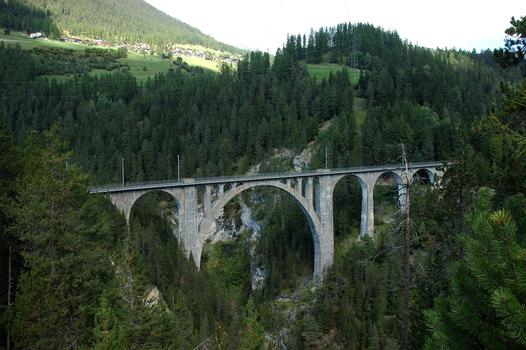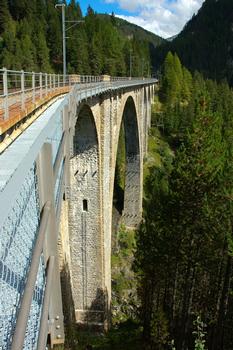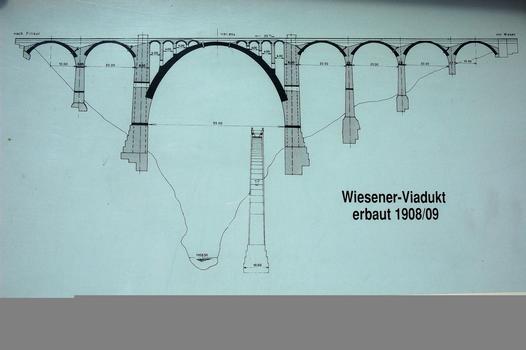General Information
Project Type
| Structure: |
Vaulted arch bridge |
|---|---|
| Function / usage: |
Railroad (railway) bridge |
| Material: |
Masonry bridge Structurae Plus/Pro - Subscribe Now! |
Location
| Location: |
Wiesen, Davos, Grisons, Switzerland |
|---|---|
| Crosses: |
|
| Part of: | |
| Coordinates: | 46° 41' 39.91" N 9° 42' 46.01" E |
Technical Information
Dimensions
| length of side spans | 20 m | |
| total length | 210 m | |
| height above valley floor or water | 88.9 m | |
| deck | deck width | 4 m |
| main arch | main span | 55 m |
| rise | 33.34 m |
Materials
| piers |
stone
|
|---|---|
| arches |
stone
|
Excerpt from Wikipedia
The Wiesen Viaduct (or Wiesener Viaduct; German:Wiesener Viadukt) is a single-track railway viaduct, made from concrete blocks with dimension stone coverage. It spans the Landwasser southwest of the hamlet of Wiesen, in the canton of Graubünden, Switzerland.
Designed by the then chief engineer of the Rhaetian Railway, Henning Friedrich, it was built between 1906 and 1909 by the contractor G. Marasi (Westermann & Cie, Zürich) under the supervision of P. Salaz and Hans Studer (RhB). The Rhaetian Railway still owns and uses it today for regular service.
An important element of the Davos–Filisur railway, the viaduct is 88.9 metres (292 ft) high and 210 metres (690 ft) long, and has a main span of 55 metres (180 ft).
Location
The Wiesen Viaduct forms part of the Davos–Filisur railway section between Wiesen and Filisur. Just 300 metres (980 ft) southwest of Wiesen railway station, it has, on its south side, a separate pedestrian bridge giving hikers access to Filisur. At the western end of the viaduct is a non functioning Hippsche turning wheel.
History
The Wiesen Viaduct structure was designed by the then Chief Engineer of the Rhaetian Railway, Henning Friedrich. Construction began in October 1906, under the direction of another engineer, Hans Studer. With the launch of the Davos–Filisur railway in July 1909, the viaduct came into operation. It cost a total of 324,000 Swiss francs to build.
The falsework used for the building of the viaduct was designed by G. Marasi, swallowed up around 500 cubic metres (18,000 cu ft) of wood, and was constructed by the Graubünden carpenter Richard Coray.
In 1926, the viaduct was the inspiration for Ernst Ludwig Kirchner's painting Brücke bei Wiesen.
Technical data
The Wiesen Viaduct is 88.9 metres (292 ft) high and 210 metres (690 ft) long. Its main span is only 3.7 metres (12 ft) wide, but also 55 metres (180 ft) long, which makes it one of the longest main spans of any masonry bridge.
To the west of the main span are two arches, each 20 metres (66 ft) long. East of the main span are four more arches, each of them also 20 metres (66 ft) long.
These technical characteristics combine to make the Wiesen Viaduct the Rhaetian Railway's largest stone and second largest bridge.
Text imported from Wikipedia article "Wiesen Viaduct" and modified on 23 July 2019 under the CC-BY-SA 3.0 license.
Participants
- Hans Studer (designer)
- Friedrich C. S. von Hennings (designer)
Relevant Web Sites
Relevant Publications
- (1909): Die Bahnlinie Davos-Filisur [Teil 3]. In: Schweizerische Bauzeitung (1883-1946), v. 53, n. 25 (19 June 1909), pp. 336-340.
- (1909): Die Bahnlinie Davos-Filisur [Teil 4]. In: Schweizerische Bauzeitung (1883-1946), v. 53, n. 26 (26 June 1909), pp. 319-324.
- (1909): Die Bahnlinie Davos-Filisur [Teil 5]. Statische Berechnung des grossen Bogens am Wiesener-Viadukt. In: Schweizerische Bauzeitung (1883-1946), v. 54, n. 1 (3 July 1909), pp. 3-10.
- (1931): Belastungsversuche am Wiesener Viadukt der Rhätischen Bahn. In: Schweizerische Bauzeitung (1883-1946), v. 98, n. 5 (1 August 1931).
- (2004): Brückenbau im 20. Jahrhundert. Gestaltung und Konstruktion. Deutsche Verlags-Anstalt, Munich (Germany), pp. 39.
- About this
data sheet - Structure-ID
20011834 - Published on:
19/04/2004 - Last updated on:
18/06/2019









